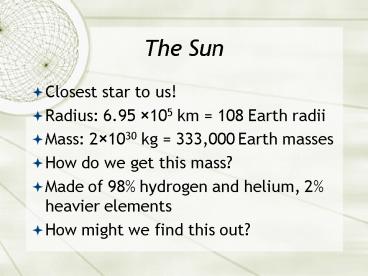The Sun - PowerPoint PPT Presentation
1 / 16
Title:
The Sun
Description:
No: once people knew how far the Sun was, and how much energy it had to produce, ... Gravitational contraction - it is how the Sun formed and became dense and hot ... – PowerPoint PPT presentation
Number of Views:65
Avg rating:3.0/5.0
Title: The Sun
1
The Sun
- Closest star to us!
- Radius 6.95 105 km 108 Earth radii
- Mass 21030 kg 333,000 Earth masses
- How do we get this mass?
- Made of 98 hydrogen and helium, 2 heavier
elements - How might we find this out?
2
The Sun
- Sphere of gas
- NO solid surface
- T5,800oK
- (11,000oF)
- at surface
3
How Does The Sun Shine?
- Is it burning like a piece of wood?
- No once people knew how far the Sun was, and
how much energy it had to produce, it was clear
this was not possible
4
How Does The Sun Shine?
- Is it due to gravitational contraction?
- Recall a gas cloud contracting under its own
gravity gets hotter.
5
How Does The Sun Shine?
- Is it due to gravitational contraction?
- No. At most this would work for only 25
million years. - Earth is a few billion years old Sun is
older. So this cant be it either.
6
How Does the Sun Shine?
- Conservation of mass-energy
- Emc2 (Einstein, 1905)
- Small mass can be turned into a lot of energy
- Nuclear fusion requires very high density and
temperature - Just as found in center of Sun
7
Gravitational Equilibrium
- Keeps Sun from
- expanding or
- shrinking
- Outward pressure
- of hot gas vs.
- Inward pull of
- gravity
8
Gravitational Equilibrium
- Just as the upward pressure of arms and legs
balances downward pull of gravity. - Outward pressure greatest at bottom of pile,
which is carrying the most weight
9
But How Did the Sun Turn On?
- Gravitational contraction - it is how the Sun
formed and became dense and hot enough to start
nuclear fusion - Then fusion produced energy and outward pressure
to stop the contraction and a balance was
achieved - We see places where stars are forming and observe
stages in this process
10
Structure of the Sun (and many other stars!)
- Sun is a very hot gas, or plasma
- So hot that all the atoms are ionized
- Sun rotates, but NOT as a solid ball
- Equator rotates faster than poles
- Suns power output 3.81026 watts
11
Digression Energy, Power, Luminosity
- Energy measured in joules
- Power is the rate at which energy is released
- What would be the units for this?
12
Digression Energy, Power, Luminosity
- Energy measured in joules
- Power is the rate at which energy is released
- Joules/second, also called watts
- This is the rating on a light bulb! Tells you the
power consumption (or output)
13
Power of the Sun
- Suns power output 3.81026 watts
- If we could capture ALL of this for just 1
second, it would be enough power for all humans
for 500,000 years!!!
14
The Sun Shines
- We see only the surface of the Sun
- The surface does NOT have fusion going on, only
at the core! - The energy from the core goes into the gas, heats
it up. - What kind of spectrum will this produce?
15
Structure of the Sun
- Multiple regions
- Photosphere
- visible surface
- Convection zone
- Turbulence
- moves energy
- Radiation zone
- Photons move
- energy
16
Structure of the Sun
- The core
- Energy production
- T15,000,000K
- 100x as dense as
- water (but still
- a gas!)
- Pressure 2x1011
- higher than at
- Earths surface!































